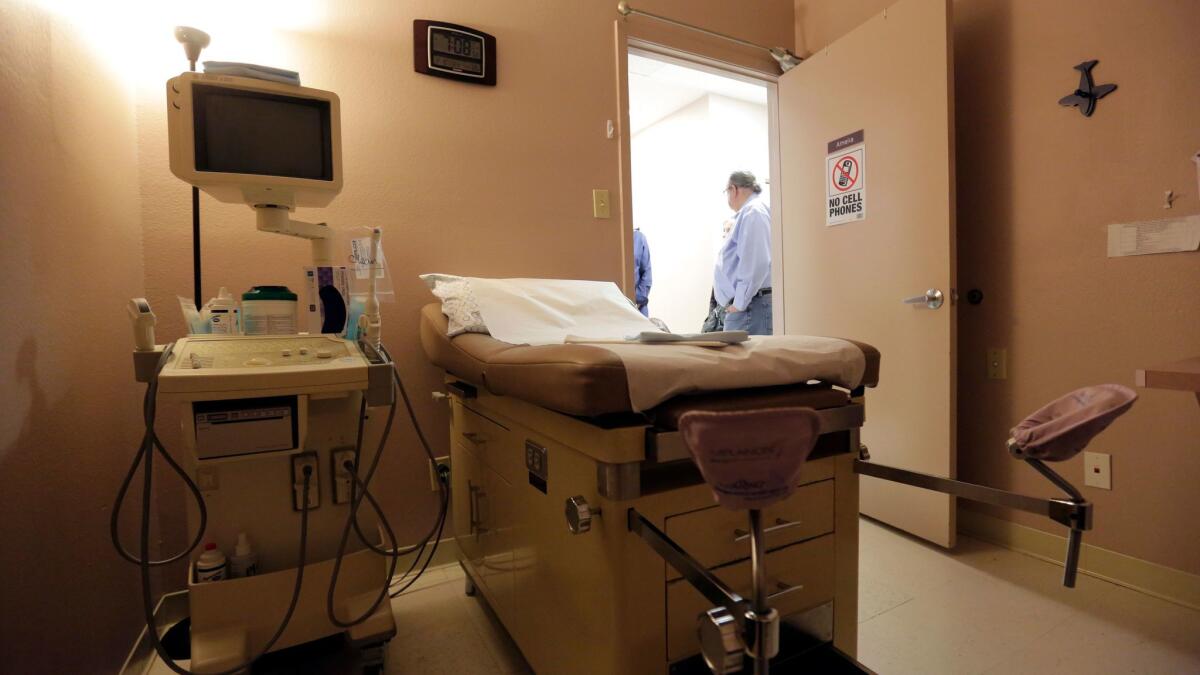Op-Ed: Restricting access to abortion makes poor women poorer

- Share via
On the 45th anniversary of Roe vs. Wade, clinic abortion rates in the United States are plummeting, having decreased by an unprecedented 25% between 2008 and 2014. Some of this decline may be due to improvements in contraceptive use, but it is likely that the hundreds of state-level restrictions that have shuttered abortion clinics and increased the cost of getting an abortion have resulted in many women being unable to get one.
Both sides of the abortion debate have long argued about the effects of terminating a pregnancy on women’s lives. By comparing women who received an abortion to those who were turned away, my colleagues and I have actual data about the experience of abortion and its alternative, carrying an unwanted pregnancy to term.
The study I led, which was published Thursday in the American Journal of Public Health, explores the socioeconomic consequences for women of receiving or being denied a wanted abortion. We recruited almost 1,000 women from 30 abortion facilities in 21 states and interviewed them by phone over five years.
We found that the most common reason women give for terminating a pregnancy is not being able to afford to support a child or, very often, another child. And women’s concerns are justified. Being denied a wanted abortion results in a reduction in full-time employment that lasts about four years; an increase in public assistance that persists until women are timed out of these programs; an increase in household poverty; an increased likelihood that women don’t have enough money to pay for food, housing and transportation; and, finally, an increased chance that women are raising children alone. In short, the study shows that not being able to access abortion services makes poor women poorer — it nearly quadrupled the odds that a woman’s household income would be below the poverty line.
It’s important to think about pregnancy and abortion in the context of real women’s lives, rather than as fodder for political debate.
Of course, how you read those results depends on how you already feel about abortion. For committed pro-choice readers, abortion is a right that enables women to take care of their existing children or order their own lives so they choose whether and when to become mothers. For committed pro-life readers, science that shows the economic harms to women who are denied access to abortion is heartless, overlooking the obvious loss of life to put a crude monetary value on the natural sacrifices of motherhood.
Regardless of how you define yourself on the politics of the issue, it’s important to think about pregnancy and abortion in the context of real women’s lives, rather than as fodder for political debate. Women balance complicated and competing demands on their time, money and affections.
Consider that more than half of the women in our study were already raising children. It was rare that the only reason for seeking an abortion was being unable to afford a child. Many women faced extraordinary challenges — homelessness, violent relationships, and taking care of loved ones with disabilities, addiction and depression. Despite those challenges, many of these women were resilient and optimistic. We found that the women who reported having the hardest time — with abortion, adoption and parenting — were doing it on their own, with partners away in prison or the military, and often alienated from judgmental families.
Everyone knows that raising children is expensive and requires sacrifices. But documenting those challenges, and the effects of public policy, can bring about needed change. In 2011, I did a study showing that if you give women a year’s supply of contraceptives, rather than making them return to a pharmacy or clinic every month or every season for refills, they are less likely to become pregnant over the course of the year. A friend of a friend commented on Facebook, “File this under Duh.” Yes, the conclusion is unsurprising. But armed with the specific findings — a 30% reduction in the odds of an unplanned pregnancy and a 46% reduction in the odds of an abortion — the District of Columbia and seven states, including California, changed their laws to allow women to get a one-year supply.
The results of our abortion-consequences study demonstrate the real costs of providing or denying women access to reproductive healthcare. The findings could help counter attempts to further restrict healthcare subsidies, and to reduce cash assistance, food aid or breastfeeding support to women. They show that government, employer, community and family supports for struggling mothers are already grossly insufficient to keep women and children from deprivation and poverty.
Perhaps the availability of hard data, and a small shift to considering unwanted pregnancy from women’s perspectives, will lead to an expansion of services and an opening of our hearts, minds and wallets.
Diana Greene Foster is a professor and director of research at Advancing New Standards in Reproductive Health, a research group at UC San Francisco.
Follow the Opinion section on Twitter @latimesopinion and Facebook
More to Read
A cure for the common opinion
Get thought-provoking perspectives with our weekly newsletter.
You may occasionally receive promotional content from the Los Angeles Times.









